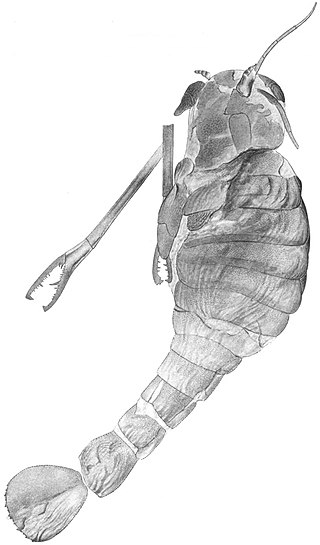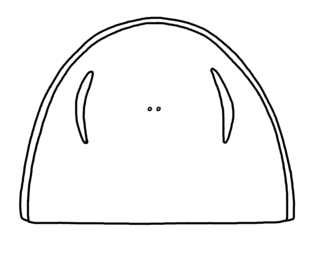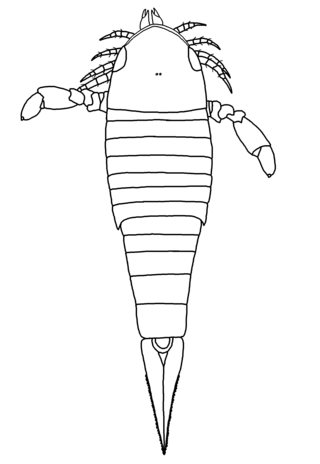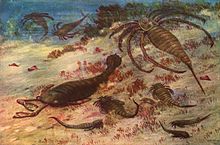
Eurypterus is an extinct genus of eurypterid, a group of organisms commonly called "sea scorpions". The genus lived during the Silurian period, from around 432 to 418 million years ago. Eurypterus is by far the most well-studied and well-known eurypterid. Eurypterus fossil specimens probably represent more than 95% of all known eurypterid specimens.

Pterygotus is a genus of giant predatory eurypterid, a group of extinct aquatic arthropods. Fossils of Pterygotus have been discovered in deposits ranging in age from Middle Silurian to Late Devonian, and have been referred to several different species. Fossils have been recovered from four continents; Australia, Europe, North America and South America, which indicates that Pterygotus might have had a nearly cosmopolitan (worldwide) distribution. The type species, P. anglicus, was described by Swiss naturalist Louis Agassiz in 1839, who gave it the name Pterygotus, meaning "winged one". Agassiz mistakenly believed the remains were of a giant fish; he would only realize the mistake five years later in 1844.

Slimonia is a genus of eurypterid, an extinct group of aquatic arthropods. Fossils of Slimonia have been discovered in deposits of Silurian age in South America and Europe. Classified as part of the family Slimonidae alongside the related Salteropterus, the genus contains three valid species, S. acuminata from Lesmahagow, Scotland, S. boliviana from Cochabamba, Bolivia and S. dubia from the Pentland Hills of Scotland and one dubious species, S. stylops, from Herefordshire, England. The generic name is derived from and honors Robert Slimon, a fossil collector and surgeon from Lesmahagow.

Carcinosoma is a genus of eurypterid, an extinct group of aquatic arthropods. Fossils of Carcinosoma are restricted to deposits of late Silurian age. Classified as part of the family Carcinosomatidae, which the genus lends its name to, Carcinosoma contains seven species from North America and Great Britain.

Hughmilleria is a genus of eurypterid, an extinct group of aquatic arthropods. Fossils of Hughmilleria have been discovered in deposits of the Silurian age in China and the United States. Classified as part of the basal family Hughmilleriidae, the genus contains three species, H. shawangunk from the eastern United States, H. socialis from Pittsford, New York, and H. wangi from Hunan, China. The genus is named in honor of the Scottish geologist Hugh Miller.

Acutiramus is a genus of giant predatory eurypterid, an extinct group of aquatic arthropods. Fossils of Acutiramus have been discovered in deposits of Late Silurian to Early Devonian age. Seven species have been described, five from North America and two from the Czech Republic. The generic name derives from Latin acuto and Latin ramus ("branch"), referring to the acute angle of the final tooth of the claws relative to the rest of the claw.

Nanahughmilleria is a genus of eurypterid, an extinct group of aquatic arthropods. Fossils of Nanahughmilleria have been discovered in deposits of Devonian and Silurian age in the United States, Norway, Russia, England and Scotland, and have been referred to several different species.

Pittsfordipterus is a genus of eurypterid, an extinct group of aquatic arthropods. Pittsfordipterus is classified as part of the family Adelophthalmidae, the only clade in the derived ("advanced") Adelophthalmoidea superfamily of eurypterids. Fossils of the single and type species, P. phelpsae, have been discovered in deposits of Silurian age in Pittsford, New York state. The genus is named after Pittsford, where the two only known specimens have been found.
Salteropterus is a genus of eurypterid, an extinct group of aquatic arthropods. Fossils of Salteropterus have been discovered in deposits of Late Silurian age in Britain. Classified as part of the family Slimonidae, the genus contains one known valid species, S. abbreviatus, which is known from fossils discovered in Herefordshire, England, and a dubious species, S. longilabium, with fossils discovered in Leintwardine, also in Herefordshire. The generic name honours John William Salter, who originally described S. abbreviatus as a species of Eurypterus in 1859.

Erettopterus is a genus of large predatory eurypterid, an extinct group of aquatic arthropods. Fossils of Erettopterus have been discovered in deposits ranging from Early Silurian to the Early Devonian, and have been referred to several different species. Fossils have been recovered from two continents; Europe and North America. The genus name is composed by the Ancient Greek words ἐρέττω (eréttō), which means "rower", and πτερόν (pterón), which means "wing", and therefore, "rower wing".

Parahughmilleria is a genus of eurypterid, an extinct group of aquatic arthropods. Fossils of Parahughmilleria have been discovered in deposits of the Devonian and Silurian age in the United States, Canada, Russia, Germany, Luxembourg and Great Britain, and have been referred to several different species. The first fossils of Parahughmilleria, discovered in the Shawangunk Mountains in 1907, were initially assigned to Eurypterus. It would not be until 54 years later when Parahughmilleria would be described.

Unionopterus is a genus of eurypterid, an extinct group of aquatic arthropods commonly known as "sea scorpions". Fossils have been registered from the Early Carboniferous period. The genus contains only one species, U. anastasiae, recovered from deposits of Tournaisian to Viséan stages in Kazakhstan. Known from one single specimen which was described in a publication of Russian language with poor illustrations, Unionopterus' affinities are extremely poorly known.

Pterygotidae is a family of eurypterids, an extinct group of aquatic arthropods. They were members of the superfamily Pterygotioidea. Pterygotids were the largest known arthropods to have ever lived with some members of the family, such as Jaekelopterus and Acutiramus, exceeding 2 metres (6.6 ft) in length. Their fossilized remains have been recovered in deposits ranging in age from 428 to 372 million years old.

Carcinosomatidae is a family of eurypterids, an extinct group of aquatic arthropods. They were members of the superfamily Carcinosomatoidea, also named after Carcinosoma. Fossils of carcinosomatids have been found in North America, Europe and Asia, the family possibly having achieved a worldwide distribution, and range in age from the Late Ordovician to the Early Devonian. They were among the most marine eurypterids, known almost entirely from marine environments.

Pterygotioidea is a superfamily of eurypterids, an extinct group of aquatic arthropods. Pterygotioids were the most derived members of the infraorder Diploperculata and the sister group of the adelophthalmoid eurypterids. The group includes the basal and small hughmilleriids, the larger and specialized slimonids and the famous pterygotids which were equipped with robust and powerful cheliceral claws.

Slimonidae is a family of eurypterids, an extinct group of aquatic arthropods. Slimonids were members of the superfamily Pterygotioidea and the family most closely related to the derived pterygotid eurypterids, which are famous for their cheliceral claws and great size. Many characteristics of the Slimonidae, such as their flattened and expanded telsons, support a close relationship between the two groups.

Herefordopterus is a genus of eurypterid, an extinct group of aquatic arthropods. Herefordopterus is classified as part of the family Hughmilleriidae, a basal family in the highly derived Pterygotioidea superfamily of eurypterids. Fossils of the single and type species, H. banksii, have been discovered in deposits of Silurian age in Herefordshire and Shropshire, England. The genus is named after Herefordshire, where most of the Herefordopterus fossils have been found. The specific epithet honors Richard Banks, who found several well-preserved specimens, including the first Herefordopterus fossils.

Necrogammarus salweyi is the binomial name applied to an arthropod fossil discovered in Herefordshire, England. The fossil represents a fragmentary section of the underside and an appendage of a pterygotid eurypterid, a group of large and predatory aquatic arthropods that lived from the late Silurian to the late Devonian. The Necrogammarus fossil is Late Silurian in age and its generic name means "dead lobster", deriving from Ancient Greek νεκρός and Latin gammarus ("lobster").

Ciurcopterus is a genus of eurypterid, an extinct group of aquatic arthropods. Fossils of Ciurcopterus have been discovered in deposits of Late Silurian age in North America. Classified as part of the family Pterygotidae, the genus contains two species, C. sarlei from Pittsford, New York and C. ventricosus from Kokomo, Indiana. The genus is named in honor of Samuel J. Ciurca, Jr., who has contributed significantly to eurypterid research by discovering a large amount of eurypterid specimens, including the four specimens used to describe Ciurcopterus itself.

This timeline of eurypterid research is a chronologically ordered list of important fossil discoveries, controversies of interpretation, and taxonomic revisions of eurypterids, a group of extinct aquatic arthropods closely related to modern arachnids and horseshoe crabs that lived during the Paleozoic Era.






















